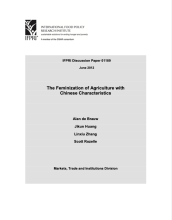Land Library Search
Through our robust search engine, you can search for any item of the over 73,000 highly curated resources in the Land Library.
If you would like to find an overview of what is possible, feel free to peruse the Search Guide.
/ library resources
Showing items 1 through 9 of 33.The Ghana Africa Research in Sustainable Intensification for the Next Generation (Africa RISING) Baseline Evaluation Survey (GARBES) survey was implemented from May to July 2014 as part of IFPRI’s Monitoring and Evaluation (M&E) of Africa RISING.
Private sector agricultural extension has expanded rapidly in many developing countries in the wake of drastic funding cuts made to public extension systems in the 1980s and 1990s.
The Mali Africa Research in Sustainable Intensification for the Next Generation (Africa RISING) Baseline Evaluation Survey (MARBES) survey was implemented during May-July 2014 as part of IFPRI’s Monitoring and Evaluation (M&E) of Africa RISING.
The Tanzania Africa Research in Sustainable Intensification for the Next Generation (Africa RISING) Baseline Evaluation Survey (TARBES) was implemented during February-April 2014 as part of the International Food Policy Research Institute’s Monitoring and Evaluation (M&E) of Africa RISING.
Fertilizer use in Thailand has become an integral part of agriculture due to the declining availability of arable land and the increasing role of rice and other agricultural exports in the economy.
The agricultural sector plays a crucial role in Cambodia’s economy, and accounts for approximately 27.3 percent of GDP. Crop cultiva-tion on Cambodia’s 4 million ha of agricultural land has become more challenging with each passing year due to low soil fertility (White et al., 1997).
The Philippines is an island nation, comprised of 7,107 islands that are split into 3 geographical divisions: Luzon, Visayas, and Mindanao. In 2013, agriculture contributed 10.45 percent to GDP (PSA-NSCB, 2014) and 31 percent to employment (PSA-BLES, 2014).
Sustainable agricultural intensification holds promise to play a
role in the broader effort to ensure food security while protecting our natural
resource base. But what would such a sustainable intensification look like in
The objectives of this paper are to help build a picture of the role of women in China’s agriculture, to assess whether or not agricultural feminization has been occurring, and if so, to measure its impact on productivity.









